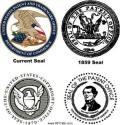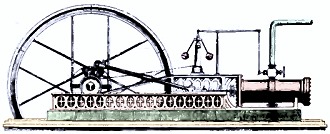Patent Information for the Inventor - Part 2
|
|
Patent Information for the Inventor
Senior Lab Technician, Westrex Corp. Part 2. The procedures followed by the Patent Office leading up to the granting of a patent. In last month's installment, the author discussed the basic steps to be followed by an inventor in applying for a patent. Now, we consider what happens to a patent application after submission to the Patent Office. With the application on its way to the Patent Office, the long wait begins, for it may take from 3 to 3 1/2 years before a patent may be granted. The patent application process is a slow one as compared to the great scientific achievements taking place each day in our electronic era. New methods are being sought by the Patent Office to reduce the amount of time involved in processing patent applications. By reducing this time and making the patents available to the public now and not 3 or 4 years from now, the engineer or scientist may be provided with the solution to some of his present-day problems. Until a new application process is developed, however, the inventor will have to wait the prescribed time - for the final reward for an inventor's perseverance is a patent granted for his invention or process. With this in mind, we will proceed to show what steps are taken from the time the application arrives at the Patent Office until the final patent is granted. Application Procedures When the application is received at the Patent Office, it is first examined for the proper filing fee and excess claims fee. If the appropriate fee is enclosed, the clerk will stamp the date of receipt on the first page of the application. This date is important, for it can mean the success or failure of a patent petition if any question should arise over the priority rights of the invention. Minor errors are not unusual, even with experienced inventors. If minor errors are detected, the inventor may be asked by mail to correct these errors, but if 82 important parts of the application are missing, such as the signature of the inventor or the oath, the application is considered incomplete. When the application is complete and in order, it will be forwarded to the Application Branch of the Patent Office where it is examined once more. If the application is found in order, a serial or file number is then stamped on the application. The terms "serial number" and "file number" are used interchangeably in Patent Office language. Once the serial number is placed on the application, the filing fee cannot be returned to the inventor. The words "patent pending" and "patent applied for" come into play now. With the application assigned a serial number, some inventors may decide to place their inventions on the public market. However, the words "patent pending" on the article for sale by the inventor, does not have any legal effect. The words "patent pending" or "patent applied for" only serve as a warning to other manufacturers that a patent is in the works and infringers may be liable to the inventor once a patent is granted. The application is then placed in a file jacket, all the contents are listed on the front of the jacket, and the whole file is forwarded to the Record Branch of the Patent Office. The application is then processed through a series of automatic machines and punch-type typewriters, which prepare index cards for Patent Office records. During this time the drawings are placed on microfilm as a permanent record. The original application is then placed in the file jacket and examined to insure that all the relevant matter has been returned to the file. The file jacket is then forwarded to a "routing specialist" of the Application Branch, who examines the application thoroughly and determines which examining division is then best suited to evaluate that particular application. A potential patent falls into three distinct categories: chemical, electrical, or mechanical. These are classified as groups, with Group I assigned to chemical, Group II to electrical, and Groups III to VII to mechanical inventions. These groups are subdivided into divisions, with each division having its own distinct field, relating to its particular group. For example, an invention relating to electronics will fall into Group II, which may have as many as 11 diversified divisions. Division 41, for example, evaluates applications on various television arts while Division 51 is concerned with applications relating to radio circuitry and electrical systems used for frequency control. The last division of any group is assigned the title of "Security Division." It is the responsibility of this division to evaluate the application for possible interest to the defense agencies. The routing specialist will forward the application to the proper examining division, where a primary patent examiner will be assigned to evaluate the invention. The inventor is then notified by mail as to the division handling his application. The primary examiner reads the application thoroughly and refers the application to one of his assisting examiners who is judged best qualified to pass on the patentability of the invention. The assistant examiner reviews applications in order, as determined by the serial number stamped on the application. It may take as long as six months before an assistant examiner is able to read the application. When the application finally comes up for examination, the examiner will read the application thoroughly and carefully inspect all drawings. If there are any minor errors the examiner will not delay the application any further. If the errors are such that the examiner cannot understand the invention, he will contact the inventor and request that the errors be rectified. The inventor will be expected to reply promptly. The assistant examiner has at his disposal all the facilities of the Patent Office which includes the search room and scientific library. He is kept abreast of the achievements taking place in his particular field by means of published material, technical magazines, and clippings - which in some cases may assist him in the evaluation of an invention. The examiner checks each claim carefully for any possible infringements on other patents. If there is any flaw in the claims, which is to be expected due to the broad language in which they are written, the examiner will notify the inventor of these rejections. The examiner expects that the inventor will do all in his power to convince him that the claims are valid. The inventor is required to answer "action letters" from the examiner within six months and if he fails to do so, the application may be considered abandoned. However, a case is not officially abandoned until after the second or third action letter. If the inventor wishes, he may request a conference with the examiner to discuss subject matter that he is unable to convey in writing. The examiner welcomes these conferences so that each side can discuss the invention in less formal language. As a result, a compromise may be reached which may lead to the issuance of a patent. Final Reward: A Patent Once the application has passed the thorough examination given by the Patent Office and a patent is finally granted to the invention, the inventor will be notified by mail to send a final filing fee of $30 and $1.00 for every claim over twenty. Patents are issued every Tuesday at noon by the Issue and Gazette Branch of the Patent Office. The patents are then delivered to the Post Office for mailing to the applicants. The patent is issued in the name of the United States of America, under the seal of the Patent Office, and signed by the Commissioner of Patents. The patent will give the title of the invention, plus the statement that the patent is being granted to the inventor, his "heirs or assigns for the term of seventeen years," giving him the right to prevent others from "making, using, or selling" the invention throughout the United States. The patent will refer to the specifications and drawings, and printed copies are made part of the patent. Patents are granted for a period of seventeen years from date of issuance. However, this term can be extended in a number of ways, if the inventor so desires. For example, the inventor has six months in which to pay the final fee. By delaying this payment until the last possible day, the inventor may be able to negotiate a profitable deal with the knowledge that the patent has already been granted on his invention. This is only one method of extending the life of a patent, but the inventor should have professional advice before attempting this ploy. Once a patent has been received by the inventor, it is no longer under the control of the Patent Office. If an infringement on the patent should occur, the inventor must defend his rights in court. After the patent has been issued to the inventor there is no guarantee he will make a profit on the patented invention. As discussed last month, to insure a profit the invention must have features that are outstanding and attractive to the public. Even if a profit does not result from the patent, the prestige alone may be well worth the time and perseverance involved in obtaining the patent. Bibliography 1. Publications obtainable from the U.S. Patent Office, Washington 25, D.C., by remittance payable to the Commissioner of Patents: Patents (as issued) - order by parent number or inventor's name and date of issue, 25 cents each. 2. Publications obtainable from the Superintendent of Documents, U.S. Government Printing Office, Washington 25, D.C. or the nearest field office of the U.S. Department of Commerce: a. "Guide for Patent Draftsmen," 15 cents b. "Patent Attorneys and Agents Available to Represent Inventors Before the United Stales Patent Office," 35 cents c. "Patent Laws," 30 cents d. "Patents and Inventions - An Information Aid for Inventors," 15 cents e. "Rules of Practice of the United States Patent Office in Patent Cases," 50 cents
Posted May 27, 2021 |
|


 By Joseph F. Verruso
By Joseph F. Verruso